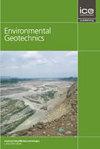Long-term environmental impact of an artificial island of solidified dredged marine silt
IF 2.2
4区 工程技术
Q3 ENGINEERING, GEOLOGICAL
引用次数: 0
Abstract
Marine dredging silt that has been solidified is commonly used as a filler material for inland reclamation and artificial island construction. However, determining the long-term environmental safety of artificial islands made of solidified silt is a challenge. A bridge-tunnel conversion artificial island made of solidified silt was the research location of this study. Laboratory tests were conducted to study the effect of cement content on pollutant pore-water concentration and hydraulic conductivity of solidified silt. The results showed that after solidification treatment, the concentration of heavy-metal concentration in the pore water of dredged silt reduced by 60%–85%, whereas the concentration of OH− increased 106–1070 times, and the hydraulic conductivity decreased by approximately three orders of magnitude. On the basis of the test results, the finite element method was used for simulating the long-term transport of heavy metal Ni2+ and OH− artificial islands. When the cement content increased from 60 to 100 kg/m3, the Ni2+ concentration in the dam around the solidified silt decreased by approximately 68%, whereas the OH− concentration increased approximately 10-fold. However, none of them exceeded the seawater water quality standard. This indicates that the long-term environmental safety of the artificial island could be ensured.固化疏浚淤泥人工岛的长期环境影响
海洋疏浚淤泥固化后,常用作填海造地和人工岛建设的填充物。然而,如何确定淤泥固化人工岛屿的长期环境安全性是一个挑战。本研究的研究地点为一个由淤泥固化而成的桥隧转换人工岛。通过室内试验研究了水泥掺量对固化粉土污染物孔隙水浓度和导水率的影响。结果表明:经固化处理后,疏浚淤泥孔隙水中重金属浓度降低60% ~ 85%,OH−浓度增加106 ~ 1070倍,导水率下降约3个数量级;在试验结果的基础上,采用有限元法模拟了重金属Ni2+和OH−人工岛的长期输运。当水泥掺量从60 kg/m3增加到100 kg/m3时,固结淤泥周围坝内Ni2+浓度下降了约68%,OH−浓度增加了约10倍。但是,没有一个海水水质超标。这表明人工岛的长期环境安全是可以保证的。
本文章由计算机程序翻译,如有差异,请以英文原文为准。
求助全文
约1分钟内获得全文
求助全文
来源期刊

Environmental geotechnics
Environmental Science-Water Science and Technology
CiteScore
6.20
自引率
18.20%
发文量
53
期刊介绍:
In 21st century living, engineers and researchers need to deal with growing problems related to climate change, oil and water storage, handling, storage and disposal of toxic and hazardous wastes, remediation of contaminated sites, sustainable development and energy derived from the ground.
Environmental Geotechnics aims to disseminate knowledge and provides a fresh perspective regarding the basic concepts, theory, techniques and field applicability of innovative testing and analysis methodologies and engineering practices in geoenvironmental engineering.
The journal''s Editor in Chief is a Member of the Committee on Publication Ethics.
All relevant papers are carefully considered, vetted by a distinguished team of international experts and rapidly published. Full research papers, short communications and comprehensive review articles are published under the following broad subject categories:
geochemistry and geohydrology,
soil and rock physics, biological processes in soil, soil-atmosphere interaction,
electrical, electromagnetic and thermal characteristics of porous media,
waste management, utilization of wastes, multiphase science, landslide wasting,
soil and water conservation,
sensor development and applications,
the impact of climatic changes on geoenvironmental, geothermal/ground-source energy, carbon sequestration, oil and gas extraction techniques,
uncertainty, reliability and risk, monitoring and forensic geotechnics.
 求助内容:
求助内容: 应助结果提醒方式:
应助结果提醒方式:


